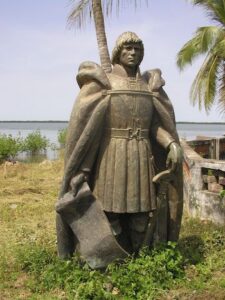
Nuno Tristão statue
*The birth of Nuno Tristão is affirmed on this date in 1390. He was a 15th-century Portuguese explorer and slave trader.
He was born in the Portuguese city of Porto and was the son of a wealthy merchant. Tristão was educated in the arts and sciences and was an avid sailor from a young age. He was a knight of the household of Henry the Navigator.
In 1441, Tristão was one of the prototypes of the lateen-rigged caravel to explore the West African coast beyond Cape Barbas. Around Rio de Oro, Tristão met up with the ship of Antão Gonçalves, sent on a separate mission, and captured a camel driver, the first African native encountered by the Portuguese. Tristão had one of Henry's Moor servants as an interpreter, interrogated Gonçalves's captive camel driver. His information led Tristão and Gonçalves to a small Sanhaja Berber fishing camp nearby. The Portuguese attacked the fishermen, taking captives, the first African slaves taken by the Portuguese back to Europe. Gonçalves returned to Portugal immediately after the slave raid, but Nuno Tristão continued south, reaching as far as Cape Blanc (Cabo Branco), before returning.
Second Voyage
1443 Tristão pressed beyond Cape Blanc to reach the Bay of Arguin. On Arguin island, Tristão encountered a Sanhaja Berber village, the first permanent settlement Henry's captains saw on the West African coast. Tristão immediately attacked it, taking villagers captive, built a fortress, and returned to Portugal with them. Tristão's report of easy and profitable slave-raiding grounds drove numerous Portuguese merchants and adventurers to apply to Henry for a slave-trading license. Between 1444 and 1446, several dozen Portuguese ships set out for slave raids around Arguin Bay.
Third Voyage
As fishing settlements around the Arguin banks were quickly devastated by the Portuguese slave raiders, in 1445, Tristão was sent by Henry to press further south and look for new slave-raiding grounds. Tristão reached the borderlands of Senegal, where the Sahara desert ends and forest begins, and the coastal population changed from Sanhaja Berbers to Wolofs. Bad weather prevented him from entering the river or landing, so he set sail back. On the way home, Tristão stopped by the Arguin banks and took another 21 Berbers captive. Tristão arrived in Portugal, declaring he had finally discovered Guinea. Portuguese slave raiders immediately descended on the Senegalese coast, but alert and better-armed natives on that coast made the slave raids not nearly as easy nor as profitable.
In 1446, Tristão embarked on his fourth (and final) trip down the West African coast. Somewhere south of Cap Vert, Tristão came across the mouth of a large river. Tristão took 22 sailors with him on a launch upriver to search for a settlement to raid. But the launch was ambushed by thirteen native canoes with some 80-armed men. Quickly surrounded, Historian Teixeira da Mota concluded that it was these Mandinka warriors who ambushed and killed Nuno Tristão.